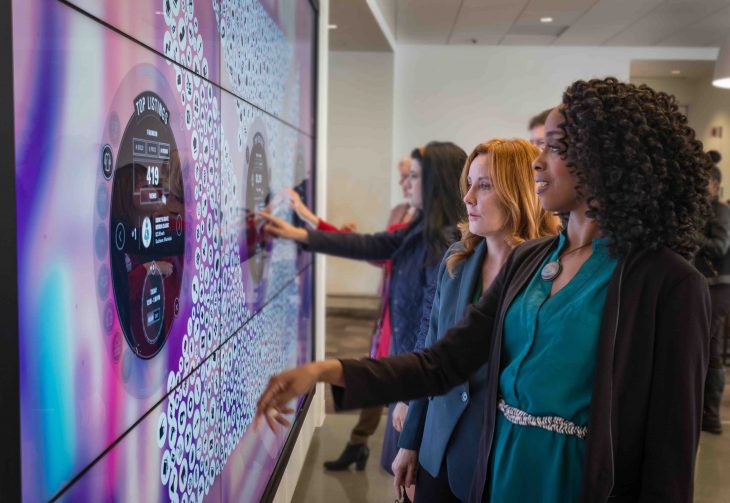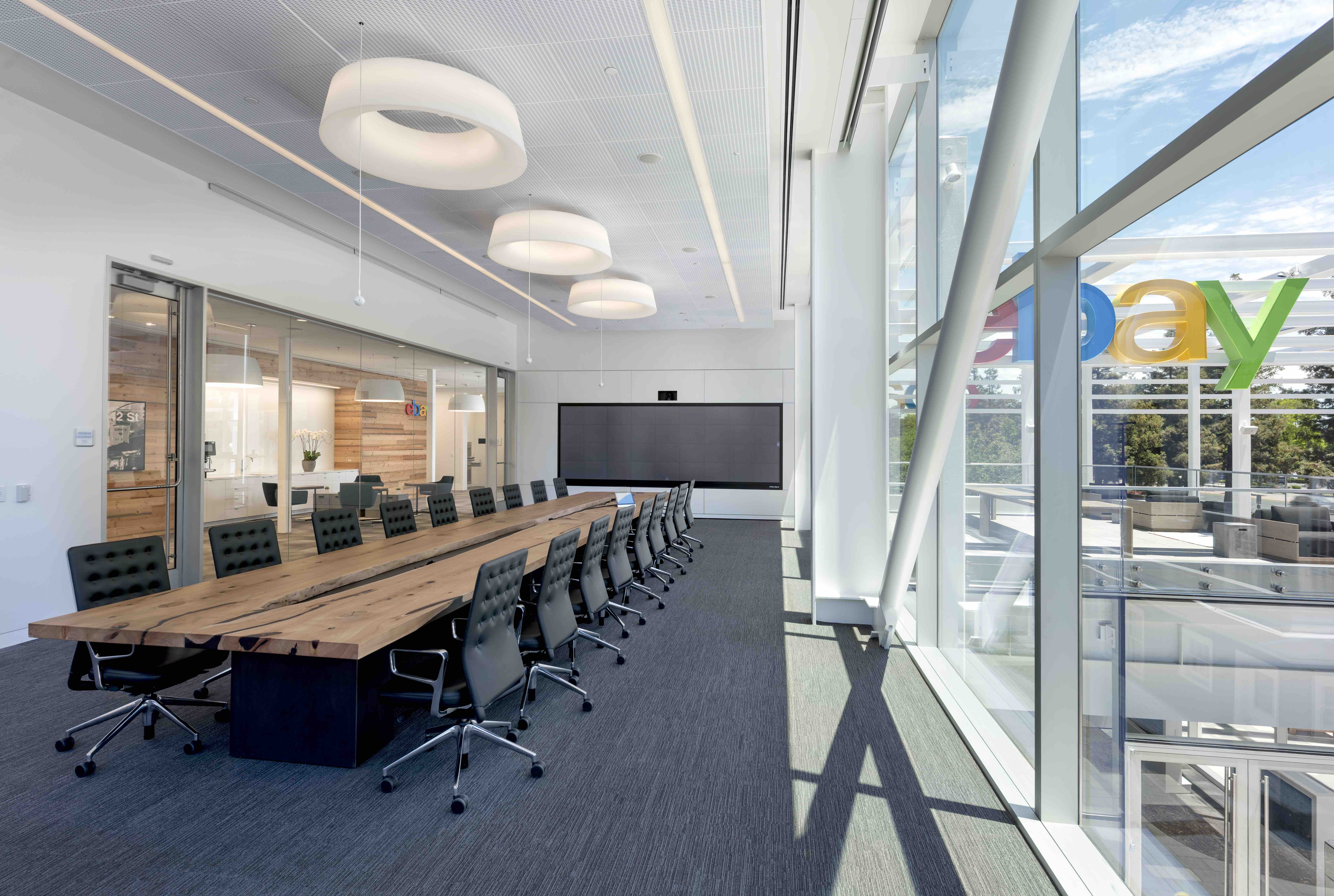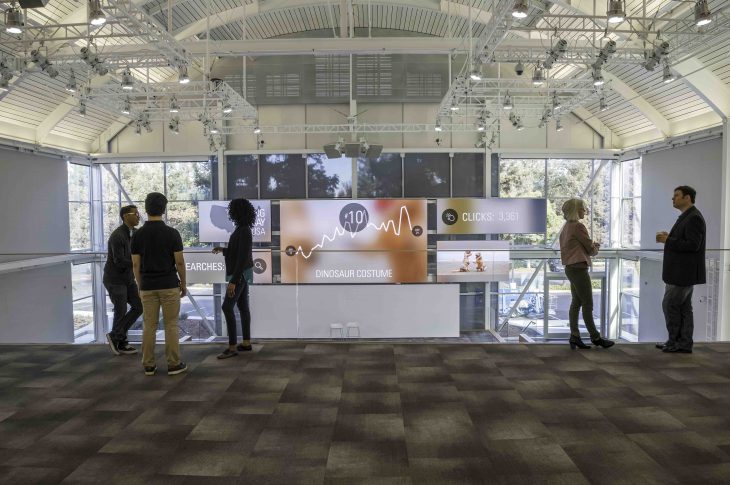Dan Goldstein, CMO of AVIXA, the Audiovisual and Integrated Experience Association, dives deep into the many audiovisual tactics design professionals can utilize in the workplace of the future.

Audiovisual technology is a vital component of modern workplace design that reaches far beyond the traditional capabilities of office monitors and speakers. The number of audiovisual technologies that can augment a space or provide a new design opportunity is growing year-over-year, and thus it’s more important than ever for workplace design professionals to consider how these new tools can improve a space’s utility and aesthetics.
The case studies referenced here highlight how various technologies are enabling companies to optimize space with smaller video conferencing rooms, engage employees and visitors with branded interactive experiences, create war-room like spaces with dozens of instantly responsive displays and even improve employee health and well-being through lighting automation.
In Video Conferencing, Every Inch Counts
As the world’s leading jobs website with 21 offices around the globe, Indeed has significant motivation to provide its employees with remote collaboration tools that are simple to use and deliver the best virtual meeting experience possible. Employing more than 8,900 workers, the company also stands to benefit from space-optimizing designs, including the now-popular huddle room concept. Following a video conference with an outside partner that was using new camera technology, Indeed saw that it could improve both its ease of collaboration and space utilization.
The new camera uses a unique three-lens design and real-time video stitching algorithms to record a 180-degree view, allowing participants to be seated just inches from the camera and still be shown on screen without distortion or cutoffs. This enables the use of smaller rooms for video conferencing without sacrificing the on-screen visibility of participants. Following a testing period, Indeed declared the new camera to be superior, and over the course of a year deployed them in nearly 700 huddles and conference rooms.
The average Indeed huddle room is roughly 10-foot x 10-foot and includes two wall-mounted flat panel displays to allow simultaneous video conferencing and screen sharing. It’s a clean, tight design that exhibits simplicity both in aesthetics and in operation. The plug-and-play camera technology requires essentially no training, and Indeed uses the popular Zoom collaboration platform for consistency and reliability.
With more and more companies utilizing remote workers or freelancers, high-quality virtual collaboration spaces are more important than ever. As a result, forward-thinking workspace designers must arm themselves with the latest technologies to enable simple and seamless virtual collaboration that is as effective as in-person meetings.

Brand Stories Come to Life through Large-Scale Interactive Experiences
In one of the latest instances of life imitating art, the once-science-fiction idea of entire walls acting as interactive video displays is now a reality – and the idea is growing in popularity. A relatively high-end technology, interactive video walls can serve as the centerpiece for engaging lobbies and communal spaces.
When eBay set out to design its “Main Street” campus in San Jose, California, they worked with AV integration professionals to realize their vision for conveying the brand’s identity in a powerful, unforgettable way. The resulting entrance to Main Street is nothing short of an eBay-themed digital playground, featuring a 15-foot touchscreen centerpiece that allows employees and visitors to tap icons representing eBay product categories – cars, shoes, handbags, and other goods – and then see how many items were sold in that category in a specific time frame.
Standing in an open, airy white room, reminiscent of eBay’s minimalist white website design, the large-scale touchscreen experience creates a direct tactile connection between the visitor and both the brand and its countless goods around the world. The whole room is digitally-transformed, with tall LED display columns lining the entry and synced with the main large-scale touchscreen to create a singularly cohesive experience for visitors.
The video wall itself uses infrared technology to track users’ motions, allowing up to three simultaneous touchpoints for multiple users to explore eBay’s vast data. To complete the branded space experience, two interactive touchscreens at reception allow employees and partners to explore eBay people, products and social impact on a more personal scale. Through this digital transformation, eBay is allowing visitors to connect more deeply with the company, the brand and its millions of products sold each day.

Multi-Panel Video Walls Enable Rapid Information Sharing
All workplaces are not created equal. In an average office, a minor delay in information sharing or communication can result in sour moods, but at the Cecil County, Maryland Emergency Response Center, operated by the Cecil County Department of Emergency Services, a delay of even just a few seconds can literally mean the difference between life and death.
As the main space where local emergency services coordinate multi-departmental responses to natural disasters, snowstorms, and other emergencies, the office is a mission-critical environment in which every tool and technology must work 100 percent of the time. One of the main functions of the office is aggregating all available information to aid decision making; thus, it’s no surprise that a recent upgrade from a projector to a 20-panel LCD video wall has changed how fast employees can gather and view various data streams and video feeds.
The original presentation system used three projectors to offer three large side-by-side displays, enabling viewing of up to three content streams simultaneously. As the county has upgraded its technologies, such as GPS trackers for school buses and emergency vehicles, there are more data streams available, requiring more screen space so that everything can be reviewed together.
With the addition of a new video-over-IP solution, up to 11 separate content streams can be directed to any of the 20 panels using a simple drag-and-drop user interface. Video feeds typically include local and national weather reports, local news, live maps that track the county’s GPS devices, any available local camera feeds, and data or other relevant online content from a PC. By displaying everything at once on a clear, bright display that’s visible from any angle, every participant can stay engaged and leaders can make decisions faster.
The design of the room didn’t have to change, in part thanks to the use of high-end LCD panels that provide excellent off-axis viewing and color reproduction, so even employees sitting to the side of the video wall can read and follow the imagery on each panel. Outside of emergency response centers, multi-panel video walls with drag-and-drop content feeds can aid in corporate meetings, multi-site video conferences and collaboration sessions where team members need to review multiple sources of information.
Leveraging Lighting Automation to Boost Employee Well-Being
Dovetailing off the consumer trend toward health, wellness, and productivity, companies are exploring how intelligent lighting can have an outsized impact on a room and its occupants. Architecture and technology experts agree that if the lighting isn’t right, people won’t want to stay in that space. It’s also generally true that natural lighting is more healthy for people than electric light.
For Innogy, an energy company based in Prague, this idea led the company to transform its office spaces with 2,000 dimmable, color-tunable LED lights that operate on a schedule designed to support workers’ circadian rhythms. The term “circadian rhythm” describes the natural daily cycle of waking states and sleeping states as well as the physiological responses that they imbue. Simply put, operating on a natural lighting schedule – sunrise to sunset – provides circadian stimulus to help people have higher energy throughout the day and enjoy a more restful sleep at night.
Based on current research, Innogy and its technology partners programmed the LED lights to change in both intensity and color temperature throughout the day to increase workers’ energy and alertness at specific times. The basic schedule mimics natural daylight at the start of business hours, decreasing in intensity until after lunch, and then increasing intensity to provide a buffer against post-meal sluggishness.
Motorized window blinds were also added as part of the same project, and both the blinds and lights can be controlled through wall-mounted touch panels. In addition to improving worker productivity and well-being, the new LED lighting system and motorized shades deliver up to 50 percent energy savings compared with the previous fluorescent lighting system.

The Future of Workplace Design
Today’s most innovative, technology-enabled workplaces are delivering instant communication, enhanced connectivity, interactive digital experiences and even health-conscious design elements that promote employee well-being and productivity. As new tools continue to come to market, designers must stay current on the variety of ways technology can augment and elevate a space’s design and functionality.


It’s true that audiovisual systems are a vital component of modern workplaces. I guess the reason why this is the case for most people nowadays is that they’ll be able to work faster if they have the right tools to help them out. Most people nowadays are starting to adopt new technology in their lives, so it makes sense if this happens in offices as well, especially since most companies aim for a globalized approach to things.
I found it helpful when you elaborated on audiovisual technology and how it’s shaping and improving a business’s workplace design. My aunt’s starting a new project in a few months and wants to use technology to attract young customers, so I’ll make sure she reads your AV tips. Thank you for explaining how audiovisual technology helps you connect with potential clients.